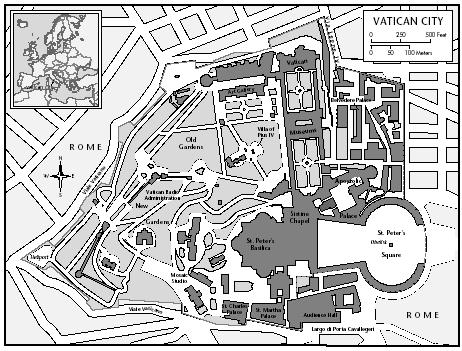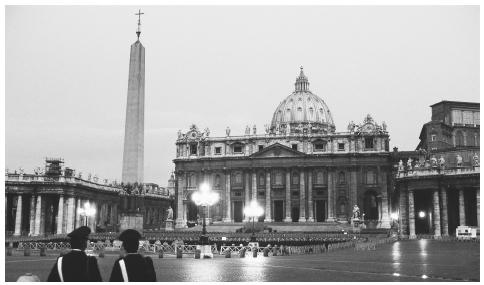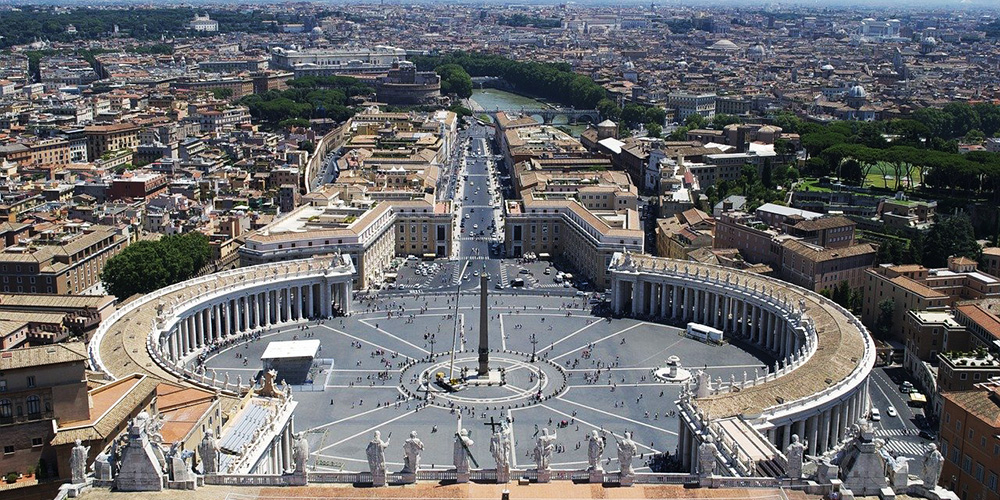Vatican City
Culture Name
VaticanAlternative Names Holy See, the Vatican Orientation
Identification. The Vatican, or Vatican City, is the center of Roman Catholicism and the residence of the bishop of Rome (the pope). The popes controlled the Papal States in what is now Italy throughout most of the Middle Ages. On 13 May 1871, the new Italian state restricted the pope’s temporal authority to the Vatican and Lateran areas of Rome and the rural retreat of Castel Gandolfo. The popes refused to accept the validity of this law until the Concordat of 11 February 1929 gave the Catholic Church special status in Italy and paid an indemnity to the now independent Vatican City.
Location and Geography. The Vatican’s 108.7 acres are completely surrounded by Rome.
Demography. There are about 850 Italian and Swiss permanent residents, along with lay workers from Catholic communities around the world.
Linguistic Affiliation. The major languages are Italian and Latin.
Symbolism. The pope represents a link to Saint Peter and Jesus. Vatican ceremonies recall the words and actions of Jesus and his followers. Candles, incense and various rituals carry symbolic meaning. The Vatican is a symbol of Church leadership and its apostolic tradition.

History and Ethnic Relations
Emergence of the Nation. The Vatican is a successor to the Papal States, which made up a large area of central Italy. After the unification of Italy, the new state annexed the Papal States after Germany defeated France, which had protected the pope’s interests, in the Franco-Prussian War (1870–1871). The popes refused to leave, declaring themselves “Prisoners of the Vatican,” until Benito Mussolini signed agreements in 1929 granting the Church special privileges in Italy and a cash settlement. The Vatican was given independence under papal rule. Since that time, the Vatican has been an independent state that sends and receives ambassadors.
National Identity. The Vatican’s identity is religious, not national. It presents itself as transnational and universal.
Ethnic Relations. The Vatican has sought ties with members of all ethnic groups as part of its universal religious identity.
Urbanism, Architecture, and the Use of Space
The Vatican is entirely urban. It has many artistic and architectural masterpieces, including Saint Peter’s Cathedral and the Sistine Chapel. Despite its small area, there is a sense of openness and comfort.
Food and Economy
Food in Daily Life. The major food style is that of Rome. Like other Italians, residents of the Vatican consider their cooking the best in the world. Pope John Paul II caused a furor when he requested Polish cooking from the papal chef.
Food Customs at Ceremonial Occasions. On New Year’s Eve, the Italian tradition is to have the meal of the seven fishes, including eels, conch, and squid. Lamb is a traditional Easter dish. For each of these meals, there is always a pasta course.

Basic Economy. The economy is based on religious work: the Vatican receives contributions from churches around the world. Tourists come to visit religious shrines and view the art. The major commercial activities are organized around religious concerns, the major industry is governance of the Church, and trade is organized around religious goods.
Land Tenure and Property. The Church owns all property in Vatican City and areas outside the Vatican covered by extraterritorial rights.
Division of Labor. The Curia rules the Church under the pope. Its members come from countries around the world and work in many governmental departments. The pope presides over the bureaucracy, delegating and consulting with his subordinates. The heads of the important bureaus tend to be cardinals.
Social Stratification
Classes and Castes. The Vatican is highly stratified. The pope is at the apex of the hierarchy and cardinal-archbishops, bishops, monsignors, priests, and others come below him, followed by the heads of bureaus. Lay workers generally rank below the clergy.
Symbols of Social Stratification. Clerical dress marks a person’s rank. The pope’s white robes distinguish him clearly. Cardinals wear red, and other ranks are noted by their style of dress and rings. Style of clothing, place in a procession line, and seating are also marks of social position.
Political Life
Government. The basic law is the Code of Canon Law. Church councils meet approximately once per century. Bishops’ synods meet periodically and offer advice, but the day-to-day running of the Vatican

is in the hands of appointed officials who oversee the Curia.
Leadership and Political Officials. There are no political parties, but the positions held by the clergy and the laity cover a wide spectrum of opinion, although those positions are not always equally represented. There is an elaborate code of etiquette for approaching officials. Generally, go-betweens are used to arrange meetings. Much is done informally. There is a feeling that consensus should be reached before decisions are published. Therefore, things are discussed at length before the pope speaks officially.
Social Problems and Control. There is little crime, and the typical problems are disputes over religious doctrine and governance. Strict statements and actions regarding conformity to doctrine, including censorship and the silencing of dissidents, have alternated with attempts at persuasion and expressions of conciliation.
Military Activity. The Vatican is officially neutral in world affairs but can mediate disputes if invited to do so. Swiss guards in medieval uniforms protect the pope and the city.
Social Welfare and Change Programs
There are social welfare programs for employees. Catholic charity organizations promote social welfare and change throughout the world.
Nongovernmental Organizations and Other Associations
In the Vatican, there are no distinctions between church and state. The Vatican works with many secular organizations.
Gender Roles and Statuses
The ethos is male-dominated. There have been efforts toward greater gender equality, especially on the part of nuns. However, as long as the priesthood is reserved for males, it will be difficult to achieve such equality. Men hold the vast majority of key positions.
Marriage, Family, and Kinship
The married people in the Vatican are mainly commuting workers whose family arrangements are the same as those in Italy.
Etiquette
The Vatican insists on modest and appropriate dress in its sacred places. Quiet is enjoined in sacred areas, and deference to the clergy is expected. There is strict adherence to speaking only when addressed and deferring to senior officials.
Religion
Religious Beliefs. The Vatican is a Catholic state whose population is virtually 100 percent Roman Catholic. There is a belief in heaven and hell and in just rewards or punishments for one’s actions on earth. There is a belief in a supreme triune God, and various saints are honored. The final judgment and resurrection of the dead are tenets of the faith.
Religious Practitioners. The Catholic clergy are the major religious practitioners and can administer the seven sacraments, depending on their rank. Bishops can ordain other priests.
Rituals and Holy Places. The Vatican is a treasure trove of special buildings and shrines. Saint Peter’s is the site of Peter’s tomb and is built over the original basilica. The Sistine Chapel in the church features the ceiling painted by Michelangelo. The Lateral Palace, once the home of the popes, is another magnificent building. Saint Peter’s Square is known around the world, and the pope often addresses the world from the square. It is also the site of many of his public masses. The religious calendar of the Catholic Church is followed, along with the rituals appropriate to that calendar.
Death and the Afterlife. The beliefs of the Catholic Church in a life after death, the existence of Purgatory, and the efficacy of prayers for the dead are followed.
Medicine and Health Care
The Vatican has an up-to-date health care system that draws on specialists from around the world.
Secular Celebrations
There are no secular holidays. The major religious feasts are Christmas and Easter, and there are other major holy days and feast days of saints.
The Arts and Humanities
The Church has a long history of supporting the arts. The Vatican is among other things a museum. Its library is a major source of knowledge about the Renaissance and European history.
The State of the Physical and Social Sciences
The Vatican is more interested in social sciences than physical sciences. It is not opposed to the physical sciences and has stated its general support for the physical sciences and their compatibility with religion. Within the Vatican, there has been more immediate application of the social sciences, particularly sociology, psychology, and political science.
Bibliography
“Future Doubtful for Bishops’ Conferences.” America 179 (4): 3, 1998.
Hersey, George L. High Renaissance Art in St. Peter’s and the Vatican: An Interpretive Guide , 1993.
Hutchinson, Robert J. When in Rome: A Journal of Life in the Vatican , 1998.
McDowell, Bart, James L. Stanfield, Elizabeth L. Newhouse, and Charles M. Kogod, eds. Inside the Vatican , 1993.
Reese, Thomas. Inside the Vatican , 1996.
Roncalli, Francesco. Vatican City: Vatican Museums , 1997.
Steinfels, Margaret O’Brien. “How the Vatican Works: An Interview with Thomas J. Reese.” Commonweal , 123 (4): 10–13, 1996.
Stickler, Alphonso. The Vatican Library: Its History and Treasures , 1989.
—F RANK A. S ALAMONE
Preparing yourself to stay with new people can be a mountain to climb alone. This is why RocApply has made this functional guide to help you with the process of acquiring information on the daily routines to observe in the land of the Vatican!
We are committed to making life easy for you! Apart from this, we can guarantee you that people here are as welcoming as it gets. You will certainly make a few friends with minimal effort here!
Cultural History
Since the disintegration of the Roman Empire and the diminishing of Byzantine power in Italy, Popes have been the de facto governors of Rome as well as many other parts of Italy.
These Papal States were hugely seized in the mid-19th century when the Kingdom of Italy was established, with Rome itself annexed in 1870. Disputes between the Popes and Italy were resolved with the 1929 Lateran Pacts, which created Holy See.
The site of the Holy See was used by Roman Emperor Nero for the Circus of Nero in the 1st century AD. The obelisk in St Peter’s Square originally dotted the center of the circus, with the circus having been the location of St Peter’s as well as many other Christian martyrs’ deaths by crucifixion during Roman demolition.
The grave of St Peter later became the location of St Peter’s Basilica under the order of Constantine.
Lifestyle
With its museums and basilica housing items of immense cultural significance, it is no wonder Holy See has been declared a UNESCO World Heritage site. Indeed, it contains some of the globe’s most glorious artworks, from Michelangelo’s frescos in the Sistine Chapel to Raphael’s decorations in the Stanze Della Segnatura.
Moreso, the Holy See Library protects hundreds of works of historical, cultural, and scientific significance.
This tiny state requires its visitors to show reverence and respect toward the Roman Catholic Church. This implies sleeveless or navel- or bust-revealing shirts, as well as those which feature profanities; shorts, above-knee length skirts, and excessive jewelry, are not allowed to be worn within Holy see territory. Hats should be removed before entering St Peter’s Basilica. Smoking is abolished, as is the use of cell phones.
One of the most visually stunning experiences visitors can have in Holy See is attending one of the Pope’s Sunday or Wednesday appearances, or his Easter or Christmas blessings. Such open-air masses in St Peter’s Square pull huge crowds.
The Vatican themselves are quiet and respectful people! This is evidenced by the level of security and peace the country offers. There is no need to contemplate about studying here.
The country lives up to its fame! Make your application today with RocApply and get started to roll with everyone else here.
Roma immortale di Martirie di Santi,
Roma immortale accogli i nostri canti:
Gloria nei cieli a Dio nostro Signore,
Pace ai Fedeli, di Cristo nell’amore.
A Te veniamo, Angelico Pastore,
In Te vediamo il mite Redentore,
Erede Santo di vera e santa Fede;
Conforto e vanto a chi combate e crede,
Non prevarranno la forza ed il terrore,
Ma regneranno la Verità, l’Amore.
Salve Salve Roma, patria eterna di memorie,
Cantano le tue glorie mille palme e mille altari.
Roma degli apostoli
Madre e guida dei Redenti,
Roma luce delle genti, il mondo spera in te!
Salve Salve Roma, la tua luce non tramonta,
Vince l’odio e l’onta lo splendor di tua beltà.
Roma degli Apostoli
Madree guida dei Redenti,
Roma luce delle genti, il mondo spera in te!
English Translation
Pontifical Hymn
O Rome immortal, city of martyrs and saints,
O immortal Rome, accept our praises.
Glory in the heavens to God our Lord
And peace to men who love Christ!
To you we come, angelic Pastor,
In you we see the gentle Redeemer.
You are the holy heir of our Faith,
You are the comfort and the refuge of those who believe and fight.
Force and terror will not prevail,
But truth and love will reign.
Pontifical March
Hail, O Rome,
Eternal abode of memories;
A thousand palms and a thousand altars
Sing your praises.
O city of the Apostles,
Mother and guide of the elect,
Light of the nations,
And hope of the world!
Hail, O Rome!
Your light will never fade;
The splendour of your beauty
Disperses hatred and shame.
O city of the Apostles,
Mother and guide of the elect,
Light of the nations,
And hope of the world!
Holy See Holy See Holy See Holy See Country Holy See National Anthem Holy See Festival Holy See History Holy See Country Holy See National Anthem Holy See Festival Holy See History Holy See Country Holy See National Anthem Holy See Festival Holy See History Holy See Country Holy See National Anthem Holy See Festival Holy See History Holy See Country Holy See National Anthem Holy See Festival Holy See History Holy See Country Holy See National Anthem Holy See Festival Holy See History Holy See Country Holy See National Anthem Holy See Festival Holy See History Holy See Country Holy See National Anthem Holy See Festival Holy See History








[…] the early 1900s, Nauru has lost at least 80 percent of its original […]
[…] on August 15, National Day of Liechtenstein is celebrated across the country. Musical events, parades, dance performances, games, and traditional cuisine are the center of attention until 10:00 p.m. […]
[…] Vecchio maintains a majority ownership of Luxottica with a 61.9% share. His other shareholdings include 28% of French real estate investment company […]